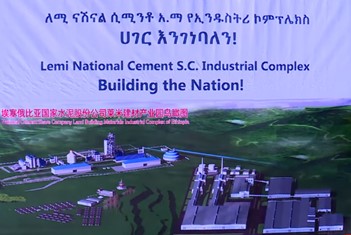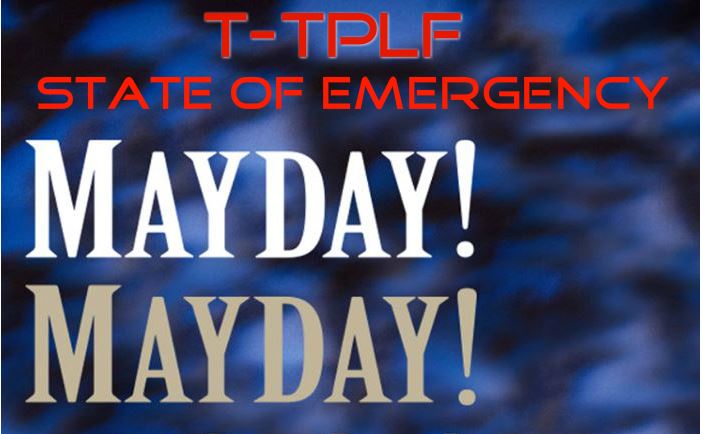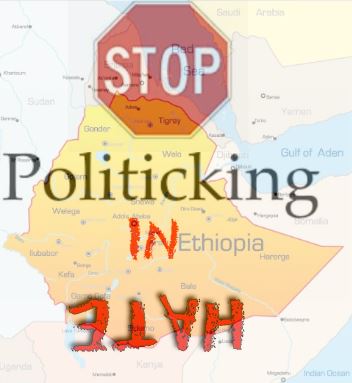Ethiopia on the Move: Prosperity Through Partnership
 The narrative not long ago was that Ethiopia is imploding.
The narrative not long ago was that Ethiopia is imploding.
The message (disinformation) spread by our shameless “friends” announced, “All Ethiopians who live in Ethiopia, abandon all hope. All expatriates, get the hell outta ‘Dodge City’ Ethiopia!”
But Ethiopia is alive and well and humming towards peace and prosperity.
I am a witness to that.
Investors are coming to explore the business environment every day.
I have met a few of them.
Many others are scoping out possibilities from America, Europe, the Middle East, and Africa.
I have met a few of them.
Chinese companies continue to invest and put their money where their mouth is despite the deafening drumbeat of propaganda and disinformation from our backstabbing “friends” exhorting, “Avoid Ethiopia as a business/investment prospect and tourist destination.”
Ethiopia has become a target of sanctions, embargoes, and all manner of punitive economic measures by our “friends” because she would not surrender her sovereignty.
Thank God, it is looking up for Ethiopia.
The darkness is literally lifting and Ethiopia is rising and shining, like I have always said.
The Grand Ethiopian Renaissance Dam (GERD) came online on February 19, 2020.
I was right there proud and grateful to the Almighty.
Millennia of darkness will be lifted from Ethiopia, literally.
With GERD, Ethiopia will finally make the long-suffered transition from poverty to prosperity.
Ethiopia today has the best-performing sovereign debt among 80 emerging markets with a return of 13 percent!
That is extraordinary because over the past year Ethiopia was beset by war, conflict, and the scourge of Covid 19.
That is not all. “Ethiopia is one of the best 10 African countries to invest.”
No doubt about it.
Ethiopia is on the move!
Ethiopia is rising higher and higher.
If you don’t believe me, come, and see.
I came.
I saw.
I am amazed at what Ethiopia is becoming.
A magnet for foreign investment.
I have seen West International Holding, one of the major cement producers in China, relocate their headquarters from South Africa to Ethiopia.
That is a big deal.
Even a bigger deal is the fact that West International joined in partnership with East African Holding Co.
Forbes Magazine described Ato Bizuayehu Tadelle Bizenu, chairman of East African Holding, as head of the “leading industrial conglomerate in Ethiopia that operates in a variety of sectors such as manufacturing of Fast-Moving Consumer Goods, tea processing, printing and packaging, transport, real estate, cement production and coal mining.”
The foundation stone for the USD2.2 billion West International-East African Holding was laid in March 2021.
In less than a year, the joint venture mega industrial complex is well underway.
Ato Bizuayehu attributed the future success of the project to teamwork. “The success of the projects will need support from all stakeholders as it will be challenging to finalize this project without ownership from all especially the region.”
East African holdings has 12 companies in different sectors of the economy with thousands of employees.
West International Holding’s headquarters relocation and joint venture (likely one of the very few such foreign investor partnerships in Ethiopia), with an established Ethiopian company sends a clear message to all Ethiopia is a safe bet for investments and doing business.
Mr. Wang FaYin, President of West International Holding Limited said, “The projects in Lemi and Dire Dawa being built with $600M budget are expected to reach the local market from Lemi and export (Dire Dawa), when finished the projects are expected to create job opportunities for up to 20,000 locals.”

The joint venture is a vote of full confidence in Ethiopia’s path to prosperity and economic viability.
Ethiopia stands to benefit from the joint venture in various ways.
The joint venture is structured on a 60-40 percent basis. Majority holding in the partnership also means West International supplies the lion’s share of the capital and bears the higher risk as well.
Cement demand in Ethiopia is huge with an annual 10 percent growth in annual consumption.
Ethiopia currently produces 8.5 million metric tons of cement annually.
When the cement factories in the partnership become fully operational, annual production capacity could increase by over 50 percent to 14.5 million metric tons.
Such production capacity could make Ethiopia one of the top cement producers and exporters in sub-Saharan Africa.
The partnership currently has 5 projects in Lemi (central Ethiopia) and Dire Dawa (eastern Ethiopia).
There is a project under study in Dawro in Western Ethiopia for coal mining and washing. These projects will have facilities to undertake “coal washing”, an industrial process in which impurities in raw coal are removed. In the first round, some 300 tons of high-quality coal are expected to be produced.
In the Lemi project, there will be capacity to produce 10 thousand tons of clinker per day (4.5 million tons of cement per year) and 30 million square meters of gypsum board annually used various construction activities (largest in Sub-saharan Africa).
The Lemi operation is also expected to produce concrete transmission poles, lime products and concrete mixes.
The 3 new projects in Lemi could lead to the formation of a major industrial park.
The Dire Dawa operation will produce 3,500 MT per day cement and reinforcement bars. Dire Dawa’s current 3,500-ton cement production factory will also expand by 30 percent.
These projects are expected to become fully operational in 18 months.
The initial investment by the partnership to get the projects underway is USD$600 million and up to USD$2.2 billion in the long run.
An expected 4-5 thousands jobs will be created directly from the joint venture projects and some 20 thousand indirectly.
Chinese technical expertise participation in the projects could reach at least one thousand which is instrumental in making the projects operational in 18 months or less.
The infusion of Chinese technical expertise could help meet Ethiopia’s critical shortage of skilled manpower in the cement industry by providing training opportunities for Ethiopians.
The possibilities for technology and knowledge transfer to sustain the cement industry in Ethiopia are substantial.
If Ethiopia could increase its cement production capacity with a substantial indigenous work force, that in turn could help Ethiopia’s foreign currency situation as the cost of hiring foreign experts is decreases and exports of cement increase.
There are some unique things about the West International Holding-East African Holding projects.
Up to 40 percent of the power supply need of the factories in Dire Dawa will come from combustion of evil tree biomass which is abundantly available in Afar and Somali regions.
All of the projects will be implemented with the full cooperation of the regional governments and investments offices at the national and regional levels.
The new investment law, the African Continental Free Trade Agreement and Ethiopia’s prosperity
Ethiopia’s new investment law should help facilitate and accelerate joint ventures similar to West International Holding-East African Holding.
Under the new law, all sectors are open to foreign investors subject to regulations and oversight by the Ethiopian Investment Board particularly in the areas joint investment with the Government of Ethiopia, exclusively domestic investors, and joint investments with domestic investors.
The new law also reforms government monopolies by eliminating certain investments previously open only to the GOE and creating a new category of investments available for partnership or joint investments with domestic investors.
Joint ventures similar to West International Holding-East African Holding could become an important element of the Africa Continental Free Trade Agreement (AfCFTA) which aims to create a single market strengthening and deepening the economic integration of the continent.
The central idea in AfCFTA is opening African markets so that there is free movement of capital and people facilitating investments continent wide.
Joint ventures between African investors and non-African investors could drive economic development and prosperity throughout Africa.
Indeed, such partnerships could answer the age-old question African leaders have failed to answer. “Why can’t African countries trade with each other and form partnerships compete on the global market?
Why must Africa always be a source of raw materials and a dumping ground for processed goods?
Ethiopia is on the move and on an irreversible course towards prosperity.
Great progress is being made in Ethiopia despite the daily challenges of life.
I have seen the progress being made in all spheres of human endeavor.
I have talked to those in high office and the man and woman in the street. I have talked to the young and the old.
For them, the enemy is poverty. The way out is prosperity.
No doubt, Ethiopia faces many problems.
Inflation erodes the purchasing power of the meagre incomes of those particularly at the lower economic levels.
Terrorism takes the lives of innocent citizens every day.
Drought has caused displacement of tens of thousands of people and the demand for emergency food aid is enormous.
There are housing shortages and lack of adequate transportation.
But despite the daily challenges of survival, Ethiopians remain incredibly resilient and optimistic.
Ethiopia still rises despite war, drought and economic woes.
Paraphrasing Maya Angelou’s poem, “Still I Rise”,
Leaving behind nights of terror and fear
Ethiopia rises
Into a daybreak that is wondrously clear
Ethiopia rises
Bearing the gifts our ancestors gave us
Dignity, unity and sovereignty
Ethiopia rises
Ethiopia is the dream and hope of Africa
Ethiopia rises. Rises. RISES.
Promoting Ethiopia’s prosperity should be job #1 for all Ethiopians
Promoting Ethiopia’s prosperity should be job #1 for all Ethiopians.
But I have found few who have taken the time and effort to examine the objective facts about Ethiopia’s trajectory to prosperity.
That is unfortunate.
To paraphrase the late US Vice President Spiro Agnew, “In Ethiopia and in the Ethiopian diaspora today, we have more than our share of the nattering nabobs of negativism. They have formed their own Self-pity Bellyaching Social Media Club. They are the ‘hopeless, hysterical hypochondriacs of history.’”
When I visited Ethiopia for the first time in 2018 after 48 years, the first place I visited (two days after I arrived) was the Hawassa Industrial Park.
I understood Ethiopia could become an economic powerhouse in Africa if it could build up its manufacturing sector.
China became a global economic power by building its manufacturing base. So did the “Asian Tigers”.
The exportation of manufacturing work (outsourcing/offshoring) has eroded the American industrial base with incalculable number of job losses.
That is why I was angrier than a goat on fire when the Biden administration axed Ethiopia out of the AGOA (African Growth and Opportunity Act) system.
By removing Ethiopia from AGOA, the Biden administration punished over two hundred thousand low-income Ethiopians by depriving them of their modest livelihood in Ethiopia’s nascent manufacturing sector.
What Biden did deeply disappointed me because it hurts Ethiopia and Ethiopians. It hurts the least among us in Ethiopia.
The joint venture between West Holding and East Africa Holding gives me great hope not only in what it aims to accomplish but also for the example it sets.
It affirms to the world of direct investments Ethiopia is open for business and all are invited to come and make their fortune.
This is not about global politics and the economic competition in Africa between the great powers.
It is about the “little people” in Ethiopia who try to survive everyday by the sweat of their labor.
It is about the wailing factory women and men of Ethiopia I recently wrote about so passionately.
The West Holding and East Africa Holding joint partnership has committed USD$600 million for the first phase. That will have a healthy impact on the Ethiopian economy.
The partnership is an affirmation that the economic reform underway in Ethiopia will bring major changes especially in the manufacturing sector and catapult Ethiopia on a straight path to industrialization.
The time for complaining and finger pointing is over.
It is time put our shoulders to the wheel and noses to the grindstone, do the heavy lifting and keep Ethiopia on a one-way path to prosperity.
I like the idea of foreign direct investment in a joint venture modality.
When there is a mutuality of interest and alignment of vision in a partnership, success is assured.
I hope other investors from the U.S., Europe, the Middle East and Africa will study the West Holding- East Africa Holding joint venture and launch their own.
Manifestly, the West Holding- East Africa Holding joint venture is a winning formula. It has produced impressive results in less than a year.
In just a few years, the joint venture could expand into other parts of Africa using the successful Ethiopian model.
One thing is as sure as the sun will rise tomorrow.
Ethiopia will rise with the sun tomorrow and shed and share her prosperity on Africa through GERD and joint ventures with African investors and others along the lines of West Holding- East Africa Holding.
Ethiopia is on the move.
When Ethiopia moves, there are only three options:
Lead Ethiopia.
Follow Ethiopia.
Or get out of the way of Ethiopia moving!
(Or create joint ventures like West Holding- East Africa Holding and keep Ethiopia on the move!)







